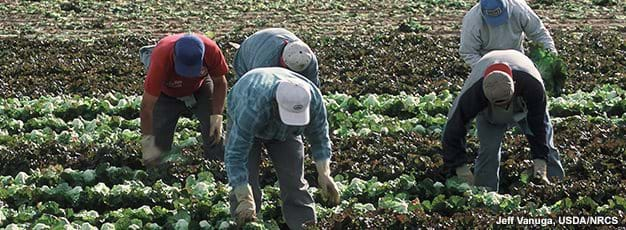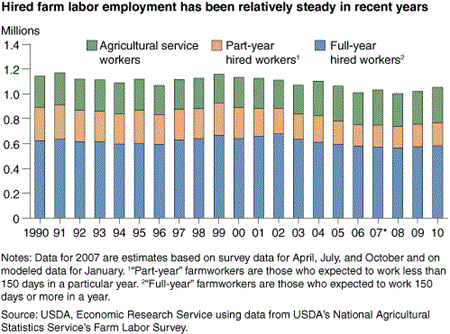Hired Farm Labor Held Steady in Great Recession

After declining for much of the previous decade, the employment of hired farm laborers, supervisors, and managers stabilized in 2008 and rose somewhat in 2009 and 2010, according to data from USDA's National Agricultural Statistics Service's Farm Labor Survey. Hired farmworkers were one of the few categories of predominantly manual laborers that did not suffer large employment losses during the Great Recession of 2007-09.
In July 2011--fully 2 years after the official end of the recession--total nonfarm wage and salary employment was still 5 percent below its pre-recession peak, according to preliminary estimates from the Bureau of Labor Statistics. Data from the Current Population Survey indicate that nonfarm wage and salary employment fell 11 percent between 2007 and 2010 for those with no more than a high school degree, while farm employment for workers with this level of education held steady.
Real (adjusted for inflation) wages, however, grew more slowly in the farm sector than elsewhere. Average wages for nonsupervisory crop and livestock workers rose 2.4 percent from $9.98 in 2007 to $10.22 in 2010 (in constant 2010 dollars), while average wages for nonfarm production workers increased 4 percent to $19.07.
Agricultural employment trends partly reflect underlying trends in the value of agricultural production, which grew from $328 billion in 2007 to $356 billion in 2010. However, much of this increase was driven by greater production of crops that use relatively little hired labor, namely feed crops and oilseeds, for which production grew by almost $20 billion, or 30 percent, over this period. In contrast, fruit, tree nuts, nursery and greenhouse commodities, and dairy products, which together accounted for 61 percent of all U.S. farm labor expenses in 2008, experienced either more moderate output growth (12 percent for vegetables) or reductions in the value of output (11 percent for dairy).
Overall, hired labor's share of net value added in agriculture slipped slightly, from 20.6 percent in 2007 to 19.3 percent in 2010, in part reflecting the shift in production shares toward less labor-intensive crops.
Farm Labor, by Marcelo Castillo and Skyler Simnitt, USDA, Economic Research Service, August 2023


